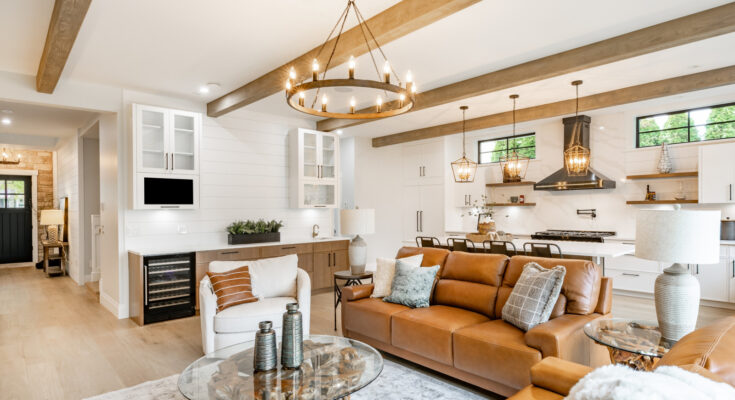Here’s Proof That You Can Even Install Decorative Beams In A Room With A Low Ceiling
Decorative ceiling beams can add visual interest and character to a room. They draw the eye upward, creating a sense of depth and texture. They can also enhance a room’s style, whether rustic or traditional, by reinforcing the use of natural materials and bold contrasts. Decorative ceiling beams (ones without a structural purpose) are often added to rooms with high ceilings to create a warmer look. If you have been considering installing decorative beams in your home, but you are concerned that your ceilings are too low for them to look good, you may be in for a surprise. Not only can exposed wooden beams work well in a room with low ceilings, but they can actually make the room look larger. Wood beams can create this effect in rooms with ceilings as low as 8 feet, in fact.
There are many things to consider when choosing the size, color, and number of decorative wood beams for your low ceiling. Once you’ve decided on the beams you want, the installation process is relatively straightforward. The items you will need to install your ceiling beams depend on the method of installation, but no matter the method, you will need a saw, screwdriver, measuring tape, and some hardware. It’s possible to purchase wood ceiling beams that already have the finish you are looking for, but if you want a look that you can’t find in a store, you will want to get some wood stain as well.
How to install wood beams onto your low ceiling
There are different ways to install decorative ceiling beams. For solid ceiling beams, it’s important to attach them to your ceiling joists. Use a stud finder to locate your ceiling joists, secure L-brackets along the joists that measure the width of the beams, and then secure the beams to the ceiling by driving nails through the L-brackets.
If you are installing beams that are hollow inside, like faux wood or wooden box beams, you can use a different method. You also don’t need to restrict the beams to ceiling joist locations. This method involves creating a ceiling track on which you will nail your beams. For this, measure and mark on your wall where the center of the beams will be, as well as the inner edges. Then, use a chalk line to mark the ceiling and install the rail boards into the ceiling along the chalk lines using toggle bolts. Finally, secure the beams to the railing boards using finishing screws or a nail gun.
No matter what method you use to put up your ceiling beams, be sure to measure everything carefully to save yourself frustration. It’s also recommended that you leave the wooden beams in the room where they will be placed for seven to 10 days before starting this project. This will help ensure that the wood won’t significantly expand or contract after placement.
Decorative beam considerations for low ceilings
There are some things to consider for this project. The first is what type of beams to use. Solid wood beams offer a natural look that might blend well with other natural features in your home. However, they are generally the more expensive choice. They are also more challenging to install and require more maintenance, like re-staining, than their hollow faux counterparts. Faux beams are also generally made from wood, but have a polyurethane coating that is easy to maintain. Natural wood decorative beams, without the polyurethane, are also available for those who want lightweight faux beams, but with a real wood finish. Of course, if you are handy with power tools, you can make your own wood beams to ensure you get precisely what you want.
As you will be installing the beams on a low ceiling, you also need to consider their size and spacing. Since your ceiling is low, the space may already tend to feel a little cramped. It’s best not to place your beams too close together. Narrow and shallow beams are also preferable for low ceilings. When it comes to staining or painting your ceiling beams, it’s important to choose whether or not you want your beams to match your wood floors. Of course, this is a personal choice, but to avoid a wood-drenched look, and making the room feel too top-heavy, choosing a light color, different from your floors is best for low-ceiling beams.



